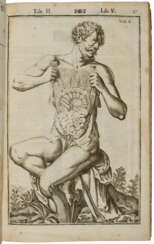sciences de l&amp




Nicolas Chuquet was a 15th century French mathematician.
The exact dates of birth and death of this scientist are not known, nor are the places of birth. Chuquet received a Bachelor of Medicine degree from the University of Paris, went to Italy in the early 1470s, and around 1480 moved to Lyon, where he worked as a physician, mathematics teacher, and scribe. He is also known to have translated Latin works into French.
In 1484 he wrote his major algebraic work, the treatise Le Triparty en la Science des Nombres (The Science of Numbers in Three Parts), now considered one of the most original mathematical texts of the 15th century. At the time, arithmeticians lacked even the most basic notations for addition subtraction, multiplication, and division. Chuquet was one of the first to propose these symbols; he also introduced the names of large numbers into common use: billion, trillion, etc. In addition to general arithmetic and rules for calculating roots, the treatise contains a doctrine of equations and a collection of problems.
This treatise was published only in 1880, but the works of Nicolas Chuquet had a significant influence on the development of algebra, and they were consistently supplemented and expanded by scientists of the following generations.




Adriaan van den Spiegel (or Spieghel), name sometimes written as Adrianus Spigelius, was a Flemish anatomist born in Brussels. For much of his career he practiced medicine in Padua, and is considered one of the great physicians associated with the city. At Padua he studied anatomy under Girolamo Fabrici.
His best written work on anatomy is De humani corporis fabrica libri X tabulis aere icisis exornati, published posthumously in 1627. In his 1624 treatise De semitertiana libri quatuor, he gave the first comprehensive description of malaria.


Jean Rey was a French chemist and physician.
Rey received a Master of Arts degree from the Academy of Montauban, then a doctorate from the University of Montpellier, and worked as a physician in his hometown of Le Bug. He was also engaged in chemical research, corresponded with R. Descartes, M. Mersenne and others.
Jean Rey was the first to express the idea of conservation of mass as applied to chemical reactions. While conducting experiments in his brother's forge, he discovered that the mass of lead and tin increases with calcination. The researcher explained this based on the assumption that air has mass and that lead and tin combine with air during calcination. In 1630 Rey published a treatise on this topic, "Experiments to find the reasons for the increase in the weight of tin and lead during calcination". As can be seen from the treatise, he realized that substances are made up of particles. His discovery of the weight of air also made possible the invention of the Torricelli barometer in 1643. Jean Rey also developed a device called the thermoscope, a precursor to the thermometer.


Louis Pasteur was a French chemist and the founder of microbiology and vaccination.
Pasteur received a bachelor of arts and sciences from the Royal College of Besançon and a doctorate from the École Normale in Paris, then spent several years as a researcher and teacher at the Lycée de Dijon. In 1848 he became professor of chemistry at the University of Strasbourg, and in the following year began to study the nature of wine fermentation, which began his revolutionary journey of most important scientific discoveries.
He invented a way to kill bacteria by boiling and then cooling the liquid, a process known today as pasteurization. Pasteur discovered the first vaccine in 1879 when he was exposed to a disease called chicken cholera. By accidentally exposing chickens to a weakened form of the culture, he demonstrated that they became resistant to the actual virus. Pasteur subsequently expanded his theory of germs and developed causes and vaccines against anthrax, cholera, tuberculosis, and smallpox, and the success of Pasteur's rabies vaccine in 1885 brought him worldwide fame.
Louis Pasteur's contribution to science, technology and medicine cannot be overemphasized. He pioneered the study of molecular asymmetry; discovered that microorganisms cause fermentation and disease; invented the process of pasteurization; saved the brewing, wine and silk industries in France; developed vaccines against the dreaded diseases anthrax and rabies, which saved millions of lives.
In 1873, Pasteur was elected an associate member of the Academy of Medicine, in 1882 - a member of the French Academy, and in 1888 in Paris was opened the Pasteur Institute. He was also awarded France's highest honor, the Legion of Honor.












![[AURACH DE ARGENTINA, Georgius]](/assets/image/picture_2278759/9457c/9357016ab787366d84491e0387358db01657663200jpg__fix_374_244.jpeg)
![[AURACH DE ARGENTINA, Georgius]](https://veryimportantlot.com/assets/image/picture_2278759/9457c/9357016ab787366d84491e0387358db01657663200jpg__fix_374_244.jpeg)





![[REMÈDES & RECETTES].](/assets/image/picture_2734777/85e13/39559a247a08aa235a6ad5af380707d51679526000jpg__fix_374_244.jpeg)
![[REMÈDES & RECETTES].](https://veryimportantlot.com/assets/image/picture_2734777/85e13/39559a247a08aa235a6ad5af380707d51679526000jpg__fix_374_244.jpeg)










![[GRIMOD de LA REYNIÈRE, Alexandre-Balthazar-Laurent (1758-1837)].](/assets/image/picture_2734763/b1d27/a61b359a3c67517168d95107573429251679526000jpg__fix_374_244.jpeg)
![[GRIMOD de LA REYNIÈRE, Alexandre-Balthazar-Laurent (1758-1837)].](https://veryimportantlot.com/assets/image/picture_2734763/b1d27/a61b359a3c67517168d95107573429251679526000jpg__fix_374_244.jpeg)
![FIBONACCI, Leonardo [c.1170-c.1250]; BOETHIUS, Anicius Manlius Severinus [c.480-524], GROSSETESTE, Robert [1175-1253]; [DE PULCHRO RIVO, Johannes, attrib.]](/assets/image/picture_2279440/69ac3/5672d49f6fe2176fe5b0465502ca1a9b1657663200jpg__fix_374_244.jpeg)
![FIBONACCI, Leonardo [c.1170-c.1250]; BOETHIUS, Anicius Manlius Severinus [c.480-524], GROSSETESTE, Robert [1175-1253]; [DE PULCHRO RIVO, Johannes, attrib.]](https://veryimportantlot.com/assets/image/picture_2279440/69ac3/5672d49f6fe2176fe5b0465502ca1a9b1657663200jpg__fix_374_244.jpeg)






![[ÉLIZABETH I, IMPÉRATRICE DE RUSSIE (1709-1761)]](/assets/image/picture_3601167/e4473/p5wns8y8w1wbu3dnrgqdcbs8o1h84zdtomuz67fdywriwpaxmfkkwwklmncwuts1700197817jpg__fix_374_244.jpeg)
![[ÉLIZABETH I, IMPÉRATRICE DE RUSSIE (1709-1761)]](https://veryimportantlot.com/assets/image/picture_3601167/e4473/p5wns8y8w1wbu3dnrgqdcbs8o1h84zdtomuz67fdywriwpaxmfkkwwklmncwuts1700197817jpg__fix_374_244.jpeg)





![[GRIMOD DE LA REYNIÈRE, Alexandre-Balthazar-Laurent (1758-1837)].](/assets/image/picture_2735026/028d2/0dfe0706bfeb59715d22c321b0e9f9ad1679526000jpg__fix_374_244.jpeg)
![[GRIMOD DE LA REYNIÈRE, Alexandre-Balthazar-Laurent (1758-1837)].](https://veryimportantlot.com/assets/image/picture_2735026/028d2/0dfe0706bfeb59715d22c321b0e9f9ad1679526000jpg__fix_374_244.jpeg)

















![[DUCHAMP, Marcel (1887-1968)]](/assets/image/picture_1298319/4a303/cd54ea0b22815aef019928e617ddc6e21614639600jpg__fix_374_244.jpeg)
![[DUCHAMP, Marcel (1887-1968)]](https://veryimportantlot.com/assets/image/picture_1298319/4a303/cd54ea0b22815aef019928e617ddc6e21614639600jpg__fix_374_244.jpeg)


